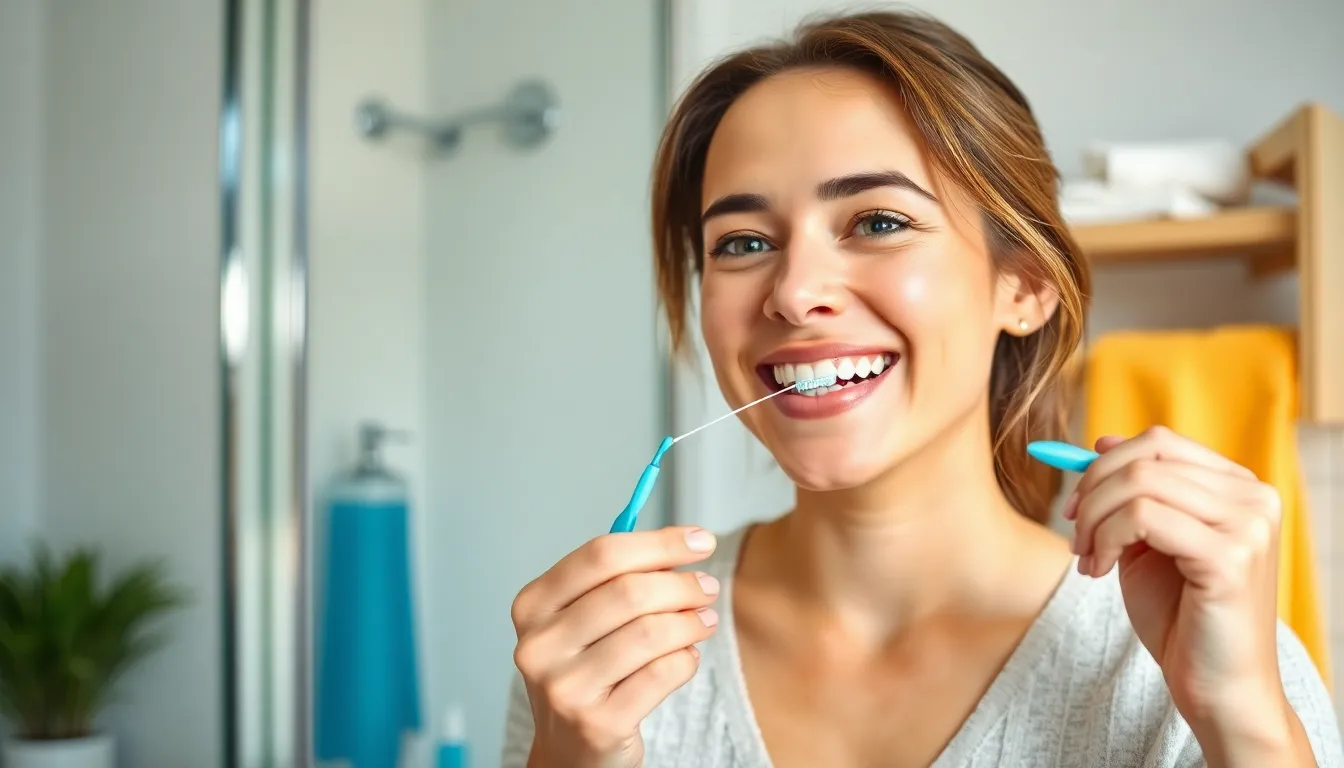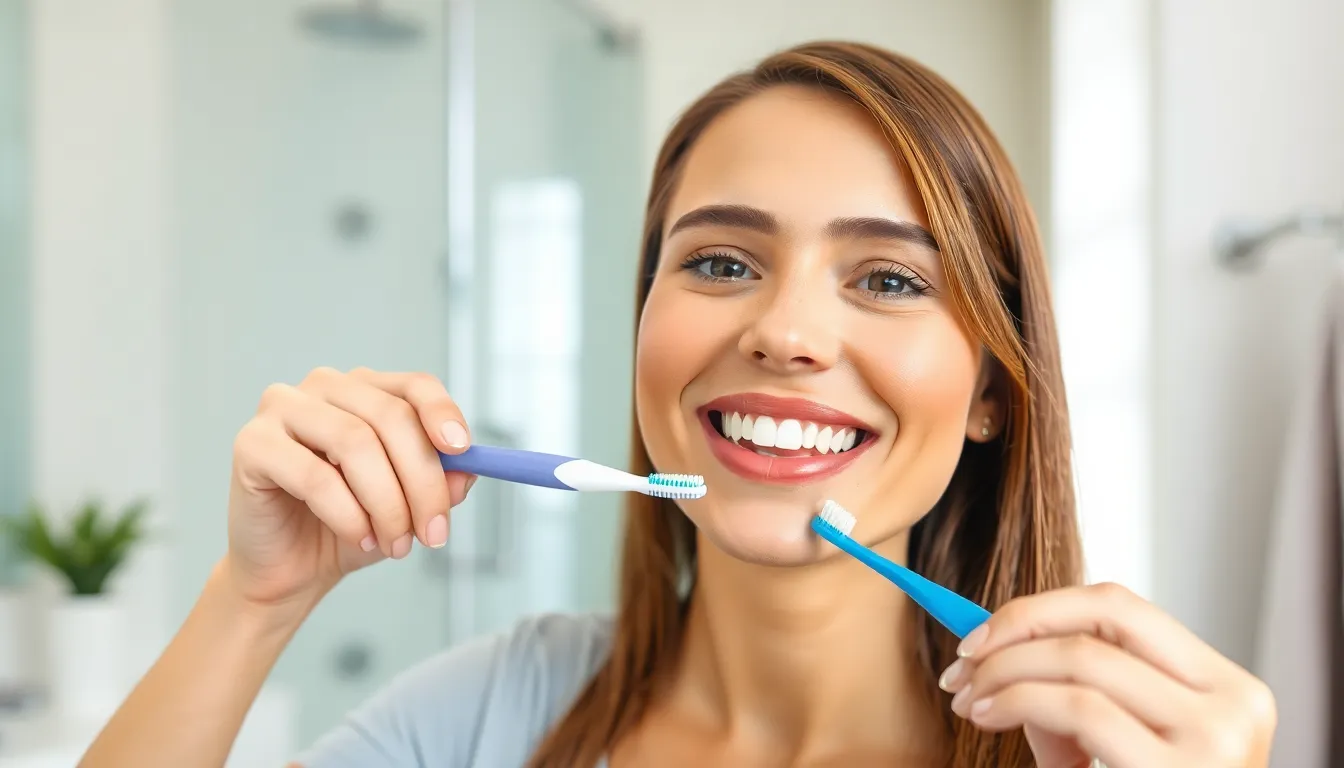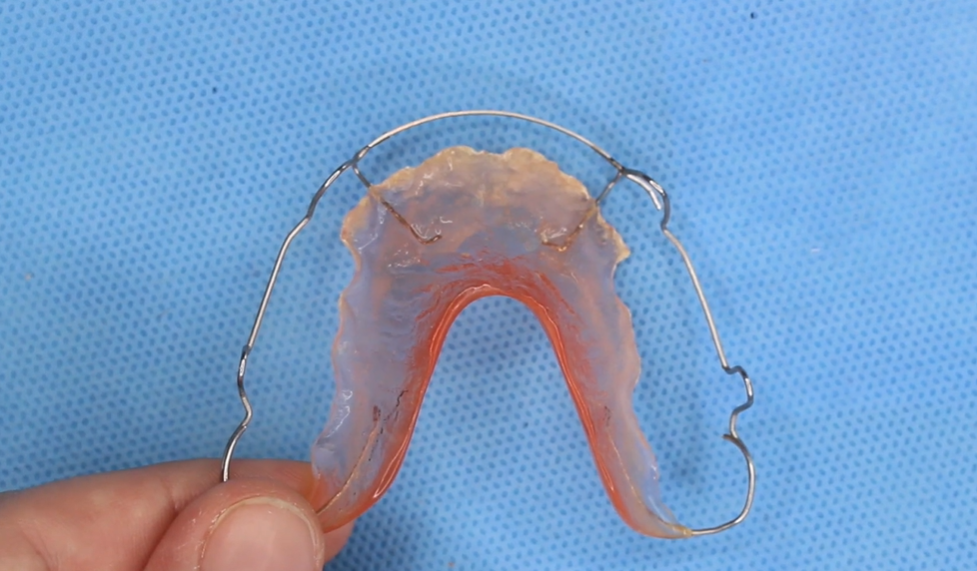If you buy through links on our site, we may earn a small affiliate commission to help support the blog - at no extra cost to you. It never influences our product selection process. Thank you!
Can you floss with veneers? It’s a common question that many veneer patients worry about after investing in their beautiful new smile. The last thing you want is to damage your dental work with improper care.
Dental veneers represent a important investment in your appearance and confidence. While these thin porcelain or composite shells transform your smile by covering imperfections, they also require proper maintenance to ensure their longevity. Understanding how to care for veneers—especially when it comes to flossing—is essential for protecting both your natural teeth and your cosmetic enhancements.
Understanding Dental Veneers: A Brief Overview
Dental veneers are thin, custom-made shells crafted from porcelain or composite resin that adhere to the front surface of teeth. These aesthetic enhancements cover imperfections like discoloration, chips, cracks, or gaps between teeth. Porcelain veneers, the most popular option, offer superior stain resistance and mimic the light-reflecting properties of natural teeth. Composite resin veneers provide a more affordable alternative but don’t last as long as their porcelain counterparts.
The veneer application process typically requires two to three dental visits. During the first appointment, your dentist removes a small amount of enamel (about 0.5mm) from the tooth surface to accommodate the veneer. After taking impressions of your prepared teeth, these molds are sent to a dental laboratory where technicians create your custom veneers. Temporary veneers protect your teeth until the permanent ones are ready. At your final appointment, the dentist bonds the veneers to your teeth using special cement that’s activated by a light beam.
“I’ll never forget when Sarah came in for her consultation,” Dr. Todd B. Harris recalls. “She’d hidden her smile for years due to tetracycline staining. After getting eight porcelain veneers on her upper front teeth, she couldn’t stop smiling. That transformation wasn’t just physical—her whole demeanor changed. That’s the power of veneers.”
Veneers last 10-15 years with proper care before needing replacement. While they’re designed to resist stains and enhance your smile’s appearance, veneers aren’t indestructible. Maintaining good oral hygiene practices, including regular flossing, extends their lifespan and preserves your oral health. Proper care ensures your investment continues to provide confidence and aesthetic benefits for many years.
Can You Floss With Veneers? The Simple Answer

Yes, you can absolutely floss with veneers, and it’s not just safe but essential for maintaining both your oral health and the longevity of your dental investment. Porcelain and composite veneers only cover the front surface of your natural teeth, leaving the spaces between teeth vulnerable to plaque buildup and decay. Daily flossing removes food particles and bacteria from these hard-to-reach areas that your toothbrush simply can’t access effectively.
Many of my patients express concern about damaging their veneers through flossing,” shares Dr. Todd B. Harris. “I reassure them that proper flossing technique actually protects their veneers by preventing gum disease and decay at the margins where the veneer meets the natural tooth structure.”
Proper flossing helps prevent several issues that could compromise your veneers:
- Gum inflammation and periodontal disease
- Decay under or near the veneer edges
- Bacterial buildup that leads to bad breath
- Staining at the margins of the veneers
Regular flossing combined with brushing ensures your beautiful smile remains healthy beneath the surface. Your veneers aren’t immune to problems—they require the same careful attention as natural teeth to maintain their appearance and structural integrity over their 10-15 year lifespan.
Why Flossing Is Crucial for Veneer Maintenance

You need to floss with dental veneers to maintain optimal oral hygiene and protect your investment. Veneers, whether made from porcelain or composite resin, don’t shield against plaque buildup, gum disease, or tooth decay on their own. Daily gentle flossing removes food particles and bacteria from areas your toothbrush can’t reach, particularly between teeth and along the gumline where problems often begin.
How Flossing Protects Your Investment
Flossing safeguards the critical bond between your teeth and veneers by keeping your gums healthy. When gums become inflamed or infected, they can weaken this essential connection, potentially causing veneers to shift or even detach completely. Healthy gum tissue provides a better seal during veneer placement, improving their durability and appearance over time. Dr. Todd B. Harris notes, “Many patients invest thousands in their veneers but overlook flossing, which can eventually compromise their results. I’ve seen patients maintain perfect-looking veneers for 15+ years simply by being diligent with their flossing routine.”
Using waxed floss or flexible floss threaders makes the process easier and safer by allowing you to glide between teeth without applying excessive pressure that might damage your veneers. Regular flossing before and after receiving veneers improves both their fit and longevity, maximizing your dental investment.
Preventing Gum Disease Around Veneers
Gum disease develops when plaque and bacteria accumulate around the gumline—a risk that exists whether you have veneers or not. Without regular flossing, plaque hardens into tartar, leading to inflammation, gum recession, and potential infection. These conditions not only compromise your gum health but also weaken the structural support for your veneers.
Daily gentle flossing prevents these issues by removing bacteria and food debris from hard-to-reach areas. One of Dr. Harris’s patients shared, “After getting my veneers, I finally committed to flossing daily. Five years later, my dentist always comments on how healthy my gums look compared to other veneer patients.” Maintaining healthy gums through consistent flossing preserves both your natural teeth and the aesthetic appeal of your veneers, ensuring they continue to enhance your smile for years to come.
Proper Flossing Techniques for Veneer Wearers

Flossing with veneers requires a delicate approach to maintain oral health while protecting your investment. Proper technique ensures you’re effectively cleaning between teeth without risking damage to your veneers or irritating your gums.
Recommended Flossing Products for Veneers
Selecting the right flossing products makes a important difference in maintaining your veneers. Waxed or shred-resistant floss stands out as the ideal choice because it glides smoothly between teeth without catching on veneer edges. Dental tape floss offers a wider surface that’s gentle yet effective for cleaning around veneers. Floss threaders provide a helpful solution for handling tight spaces, allowing you to thread floss beneath and around veneers where access is limited. Soft interdental brushes serve as excellent alternatives for veneer wearers who find traditional flossing challenging, as they clean between teeth without applying excessive pressure on the veneers.
“I’ve seen remarkable differences in veneer longevity between patients who use appropriate flossing products and those who don’t,” notes Dr. Todd B. Harris. “One patient switched to waxed floss and floss threaders after experiencing discomfort with regular floss, and her veneers have maintained their pristine condition for over a decade.”
Step-by-Step Flossing Guide for Veneer Patients
Start by cutting approximately 18 inches of waxed or shred-resistant floss and wrap most of it around your middle fingers, holding a small section taut between your thumbs and index fingers. Gently slide the floss between your teeth using a back-and-forth motion, avoiding snapping or forcing the floss down, which could damage your veneers or harm your gums. Create a ‘C’ shape with the floss around each tooth, carefully moving up and down along the sides to clean effectively without putting pressure on the veneer edges.
Consider using floss threaders for areas that are difficult to reach, particularly around bridges or tightly placed veneers. Interdental brushes can clean wider spaces between teeth, providing another gentle option for veneer maintenance. Move systematically through all your teeth, paying special attention to the areas where veneers meet natural teeth, as these junctions can trap food particles and plaque. Finish by rinsing your mouth thoroughly to remove any loosened debris.
Common Concerns About Flossing With Veneers

Many veneer patients worry about damaging their investment during routine oral care. These concerns are natural considering veneers represent both a financial commitment and a important improvement to your smile aesthetics.
Will Flossing Damage or Dislodge My Veneers?
Flossing won’t damage or dislodge properly placed veneers when you use the correct technique. Gentle motions protect the veneer margins while supporting your gum health around the restoration. Patients should avoid snapping floss down aggressively between teeth, as this can irritate gums and potentially damage the edges of veneers. Waxed floss glides more smoothly between teeth and minimizes the risk of catching on veneer edges.
“I had a patient who avoided flossing for months after getting her porcelain veneers because she was terrified of popping them off,” recalls Dr. Todd B. Harris. “When she finally came in for her check-up, we discovered early gum inflammation that could have compromised her beautiful results. After demonstrating proper flossing technique, she now maintains perfect gum health without any damage to her veneers.”
Special Considerations for Different Veneer Types
Porcelain veneers require particular attention during flossing due to their delicate edges. These premium restorations benefit from waxed floss that slides easily without catching on the margins. Alternatives like water flossers or interdental brushes work exceptionally well for porcelain veneers, providing thorough cleaning with minimal risk.
Composite veneers demand similar gentle treatment during flossing sessions. These more affordable options can be more susceptible to scratching or dislodging if abrasive floss is used with excessive force. Soft cleaning tools specifically designed for dental restorations help preserve the integrity of composite veneers while effectively removing plaque and debris.
Additional Oral Hygiene Tips for Veneer Longevity

Maintaining veneers requires more than just proper flossing techniques to ensure they last for years. Daily brushing with a soft-bristled toothbrush and non-abrasive toothpaste prevents surface scratches that can dull your veneers’ appearance. Electric toothbrushes work wonderfully for veneer care as they provide consistent pressure without damaging the delicate porcelain surfaces.
“I’ve noticed a remarkable difference in veneer longevity between patients who use appropriate oral hygiene products and those who don’t,” explains Dr. Todd B. Harris. “One patient came to me after having her veneers for just three years with noticeable staining around the edges. After switching to a non-abrasive toothpaste and incorporating a fluoride mouthwash into her routine, her next check-up showed important improvement in both veneer appearance and gum health.”
Rinsing with an alcohol-free fluoride mouthwash strengthens the natural tooth structure beneath your veneers and helps prevent decay at critical margin areas. Regular dental check-ups every six months allow your dentist to professionally clean areas you might miss and catch potential problems before they compromise your veneers.
Avoid using your teeth as tools for opening packages or biting fingernails as these habits can chip or crack even the most durable veneers. Wearing a nightguard protects your investment if you grind your teeth during sleep, preventing excessive pressure that can damage veneer surfaces or edges.
For coffee, tea, or wine enthusiasts, drinking through a straw minimizes contact with your veneers, reducing the risk of staining particularly around the margins where your natural teeth meet the veneer material. Cutting back on highly acidic foods and beverages helps preserve both your veneers and the underlying tooth structure from gradual erosion that can undermine veneer attachments.
Conclusion
Flossing with veneers isn’t just possible—it’s essential for protecting your investment. With the right technique and proper tools like waxed floss or water flossers you can maintain both your veneers and natural teeth for years to come.
Remember that your veneers only cover the front surface of your teeth leaving the spaces between vulnerable to decay and bacteria. By incorporating gentle daily flossing into your routine you’re safeguarding not only your oral health but also extending the lifespan of your beautiful smile.
Treat your veneers with care and they’ll reward you with a confident lasting smile that can endure for 15+ years. Your future self will thank you for the few minutes spent flossing each day!
Frequently Asked Questions
Can I floss with dental veneers?
Yes, you can and should floss with dental veneers. Flossing is essential for maintaining oral health and protecting your investment in veneers. Since veneers only cover the front surface of your teeth, the spaces between teeth remain vulnerable to plaque buildup and decay. Daily gentle flossing helps remove food particles and bacteria from these areas, protecting both your natural teeth and veneers.
Will flossing damage my veneers?
No, proper flossing will not damage your veneers. Using the correct technique and appropriate products like waxed or shred-resistant floss will ensure you clean effectively without risking damage. Avoid aggressive flossing, which can irritate gums and potentially harm veneer edges. When done correctly, flossing actually helps protect the bond between your teeth and veneers by maintaining healthy gums.
How often should I floss with veneers?
You should floss once daily with veneers, just as dentists recommend for natural teeth. Daily flossing prevents plaque buildup, gum disease, and decay at the margins where veneers meet natural tooth structure. Consistent flossing is one of the key factors that can extend the lifespan of your veneers from the average 10-15 years to potentially over 15 years.
What type of floss is best for dental veneers?
Waxed or shred-resistant floss is best for dental veneers. These types glide more smoothly between teeth, reducing the risk of catching on veneer edges. Dental tape is another good option as it’s wider and gentler on gums. For difficult-to-reach areas, consider using floss threaders or water flossers, which can be particularly effective for cleaning around veneers without applying excessive pressure.
Are there different flossing techniques for porcelain versus composite veneers?
Both porcelain and composite veneers require gentle flossing techniques, but there are slight differences. Porcelain veneers are more stain-resistant but can chip if flossing is too aggressive. Composite veneers are softer and may scratch more easily, requiring extra gentleness. For both types, use waxed floss and consider alternatives like water flossers, which can be particularly effective for porcelain veneers without risking damage.
How do I floss properly with veneers?
To floss properly with veneers, use about 18 inches of waxed floss, wrap most around your middle fingers, and hold a 1-2 inch section between thumbs and forefingers. Gently slide the floss between teeth using a back-and-forth motion, curve it around each tooth in a C-shape, and clean with up-and-down movements. Be especially careful around the gumline and where veneers meet natural teeth. Avoid snapping the floss, which could damage veneer edges.
Can gum disease affect my veneers?
Yes, gum disease can significantly affect your veneers. Inflamed or infected gums can weaken the bond between your teeth and veneers, potentially causing them to shift or detach. Gum recession from periodontal disease can also expose the margins of your veneers, affecting their appearance and integrity. Regular flossing prevents gum disease by removing plaque from the gumline, protecting both your natural teeth and the aesthetic appeal of your veneers.
Should I use mouthwash with veneers?
Yes, you should use mouthwash with veneers, but choose alcohol-free fluoride mouthwash. This helps strengthen the natural tooth structure beneath veneers without risking damage to the bonding material. Alcohol-based mouthwashes can potentially weaken the adhesive over time. Rinsing with mouthwash after brushing and flossing provides additional protection against bacteria and helps maintain fresh breath without compromising your veneers.
How long will my veneers last if I floss regularly?
With regular flossing and proper oral hygiene, veneers can last 15+ years compared to the average 10-15 year lifespan. Dr. Harris notes a significant difference in veneer longevity between patients who maintain diligent flossing routines and those who don’t. Flossing helps prevent decay at veneer margins and maintains healthy gums, which are crucial for preserving the structural integrity and appearance of veneers over time.
What other oral hygiene practices should I follow with veneers?
Besides daily flossing, brush twice daily with a soft-bristled toothbrush and non-abrasive toothpaste to prevent scratching. Consider using an electric toothbrush for effective cleaning without excessive pressure. Attend regular dental check-ups to catch potential issues early. Avoid using teeth as tools and consider wearing a nightguard if you grind your teeth. For staining beverages, drink through a straw to minimize contact with veneers.






